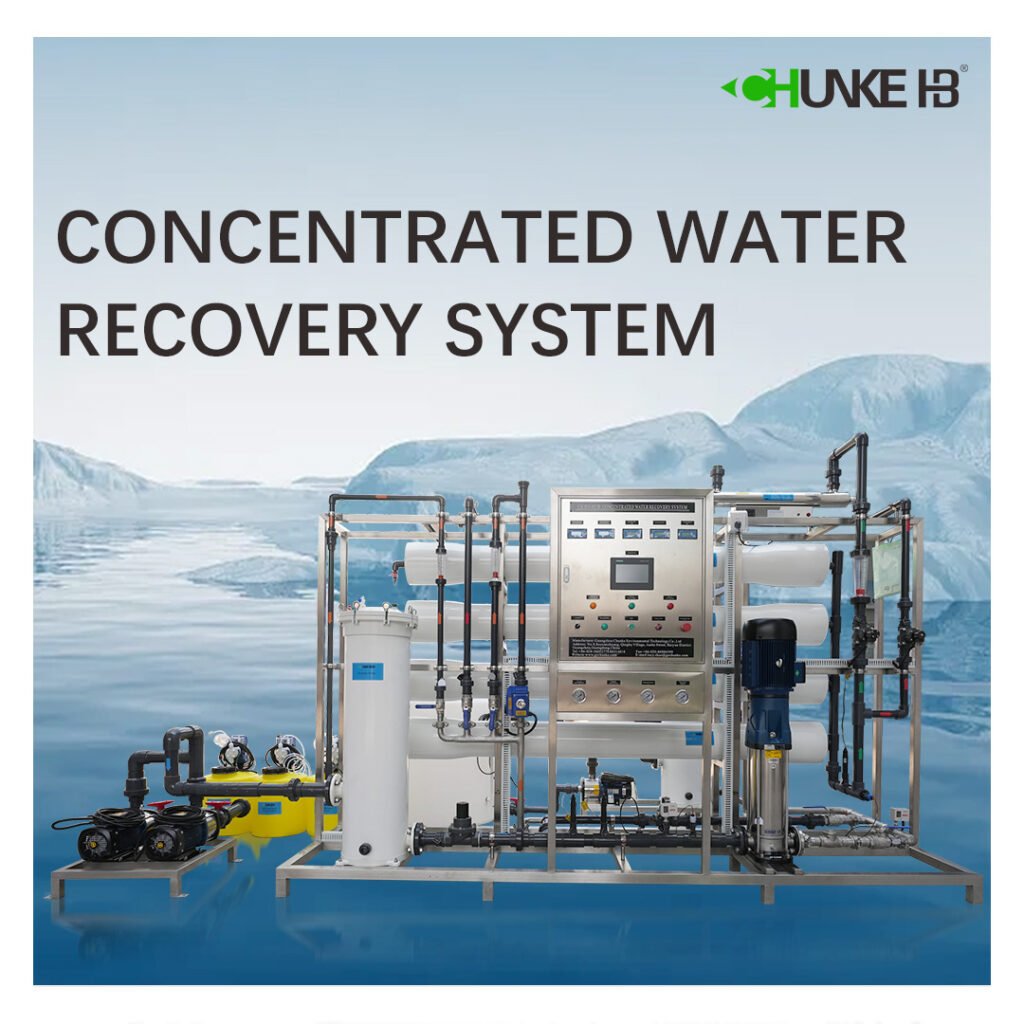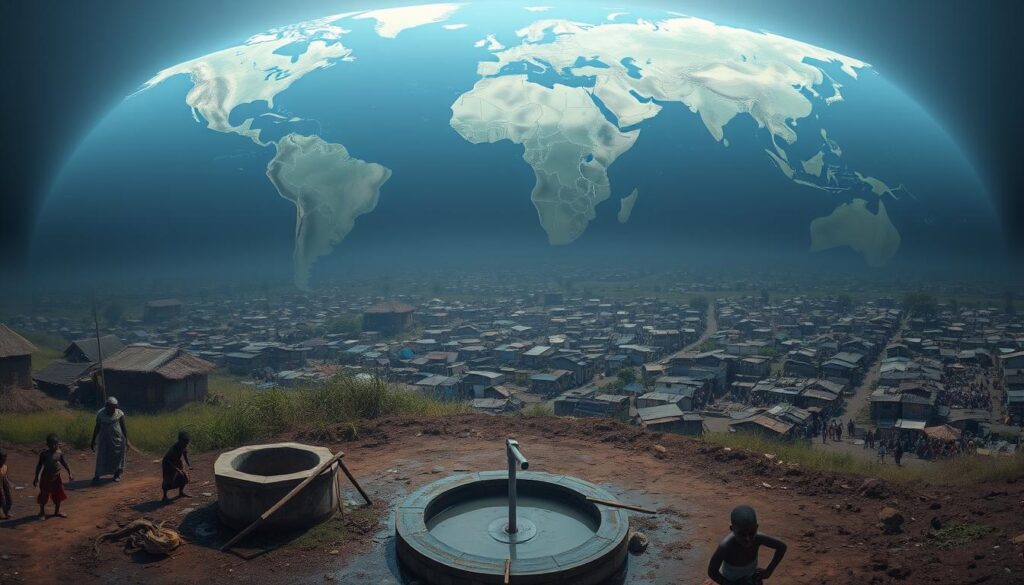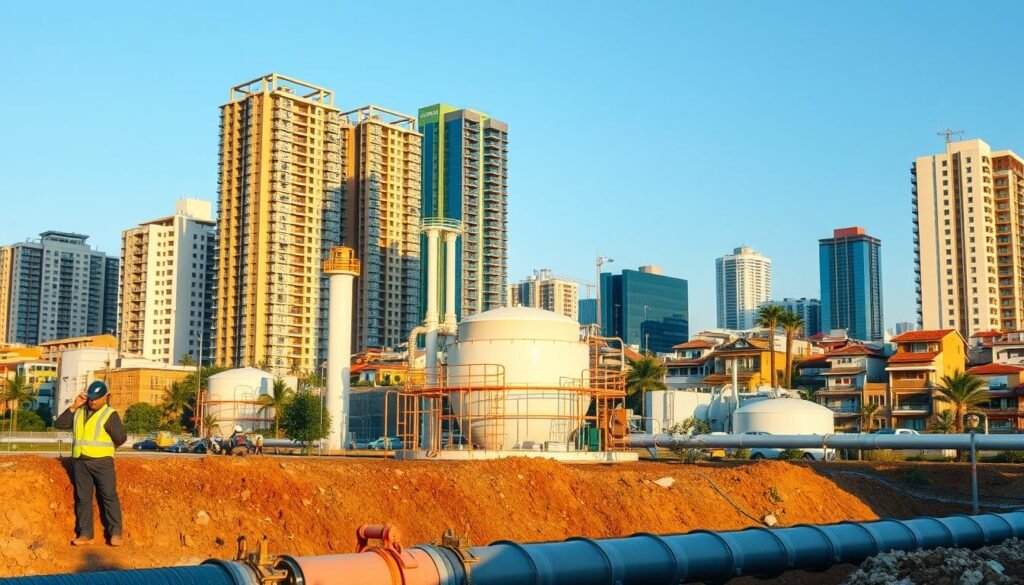Having access to safe water and sanitation is key to our health and dignity. But, billions will still lack these basics by 2030 if we don’t act fast. At Chunke Water Treatment, we’re working hard to find solutions to this problem.
Right now, half the world faces severe water scarcity every month. Also, 2.2 billion people don’t have safe drinking water. Despite some progress, we need to do much more to meet our 2030 goals. Clean water and sanitation are not just needs; they’re lifelines that prevent disease and help communities grow.

With only 0.5% of Earth’s water usable, every drop is precious. Over 3.5 billion people lack safe sanitation, and 2 billion have no basic handwashing facilities. These gaps harm communities, economies, and futures. Our systems aim to turn challenges into opportunities through innovation.
Every year, not acting fast enough makes things worse. As leaders in water treatment, we push for solutions that can help everyone have access to safe water.
Key Takeaways for Water and Sanitation
- 2.2 billion people globally lack access to safely managed drinking water.
- By 2030, a 40% freshwater shortfall threatens global stability.
- Half the world’s population faces water scarcity monthly.
- Universal access requires sixfold faster progress in water and sanitation.
- Handwashing facilities remain scarce in 43% of schools worldwide.
The Global Impact of Water and Sanitation on Public Health
Access to clean water is a big challenge for public health around the world. Over 2.2 billion people don’t have safe drinking water. Another 1.7 billion use water that’s not clean.
These issues lead to diseases that can be prevented. Almost 432,000 children die every year from diarrhea.
Current Statistics on Global Health Outcomes
- 3.5 billion people lacked safely managed sanitation in 2022
- 1.5 billion use unprotected wells or springs
- 2 billion lack basic handwashing facilities
“Unsafe water, sanitation, and hygiene cause 829,000 deaths annually from diarrheal disease,” according to World Health Organization data.
The Connection Between Clean Water and Disease Prevention
Dirty water leads to diseases like cholera and typhoid. It also causes schistosomiasis. Our systems, like reverse osmosis and ultrafiltration, remove harmful pathogens.
This makes water safe for people who need it most.
How Water Quality Affects Human Development
Water problems cause kids to miss 272 million school days a year. Women spend 200 million hours daily getting water. This time could be spent on education and work.
Having clean water helps kids go to school more. It also helps women work more. This improves public health and helps communities grow.
Understanding the Worldwide Water Crisis in 2023
Every day, 2 billion people lack safe drinking water, and 3.6 billion don’t have proper sanitation. The global water crisis is real for millions. Climate change makes droughts and floods worse, reducing freshwater.
More people and industrial needs put a strain on water. This leaves 50% of the world’s population facing water shortages every month.
In sub-Saharan Africa, 81% of freshwater is for farming. This leaves little for homes. By 2025, 1.8 billion could face severe water shortages. This could displace 700 million by 2030, according to UN Water.
Every year, 260,000 children under five die from waterborne diseases. Also, 2.8% of maternal deaths are due to unsafe water.
- 703 million lack clean water—1 in 11 people globally
- Women and girls trek 3.7 miles daily to collect water, losing 250 million hours weekly
- Flint, Michigan, exemplifies urban water crises, where 81,000 residents faced lead-contaminated tap water
At Chunke Water Treatment, we tackle these issues with advanced systems. Our technologies reclaim, purify, and conserve water. We use reverse osmosis and ultrafiltration to remove contaminants, ensuring safe water access.
Every $1 invested in water solutions brings $4 in economic returns. This shows innovation can make a big difference.
The crisis needs urgent action. By 2030, UN Sustainable Development Goal 6 aims to end water poverty. Let’s work together to ensure no community faces the global water crisis alone.
The Critical Role of Water and Sanitation in Sustainable Development
Water and sanitation are key to sustainable development. They affect health, economies, and the environment. The United Nations’ Sustainable Development Goal 6 (SDG6) aims to ensure clean water and sanitation for all by 2030. At Chunke Water Treatment, we focus on technologies that meet these global goals and tackle local challenges.
Water Goals Within the UN Sustainable Development Framework
SDG6 connects with reducing poverty, education, and fighting climate change. In the Americas, 28 million people lack access to clean water, and 15.6 million practice open defecation. These issues block progress in many areas. Good water sanitation systems lower child deaths from diarrhea, boosting community strength.
Economic Development Through Improved Water Access
| Issue | Impact |
| Lack of clean water | Loss of 443 million schooldays yearly in developing countries |
| Improved sanitation | Rises local GDP by 2-3% (World Bank) |
Environmental Benefits of Proper Water Management
- Healthy watersheds protect biodiversity
- Efficient irrigation reduces water waste by 30%
- Wastewater treatment prevents marine pollution
Chunke’s advanced filtration systems cut chemical use by 50%. This helps the environment and economy. By following sustainable development principles, we help communities grow while keeping nature intact. Every step in water sanitation moves us closer to a healthier, more equitable world for all.
Waterborne Diseases: Prevention Through Advanced Treatment Technologies
Every year, waterborne diseases kill over 2.2 million people worldwide. Most of these deaths are children under five. In the U.S., waterborne outbreaks caused more than 430,000 illnesses between 2001 and 2002. Chunke Water Treatment aims to stop these tragedies with new technologies.
Germs like E. coli and cryptosporidium grow in untreated water. They spread fast when water systems fail. For example, in 2000, an outbreak in Canada made 2,300 people sick. This shows how urgent it is to use advanced filters.
| Pathogen | Minimal Infectious Dose (cells) |
| Shigella spp. | 10–102 |
| Campylobacter spp. | ~500 |
| Vibrio cholerae | 10³ |

Our systems use reverse osmosis and ultrafiltration to fight germs. They can catch pathogens as small as 0.003 microns. This helps protect both surface and groundwater. In the EU, our technology has cut cryptosporidium cases by 30%.
Old water systems are a big problem: 15.6 million U.S. homes use unregulated wells. Our systems fit into these networks, meeting EPA rules. By fixing these issues, we lower outbreak rates and healthcare costs. Waterborne disease costs the world $12 billion each year.
How Modern Water Treatment Systems Are Saving Lives
At Chunke Water Treatment, we design systems that turn contaminated water into a lifeline for communities worldwide.
Every year, unsafe water kills over 1.7 million people. Thanks to reverse osmosis systems, ultrafiltration systems, and electrodeionization systems, this number is dropping. These systems make water safe for drinking, healthcare, and industry.
Reverse Osmosis Technology: Removing Harmful Contaminants
Our reverse osmosis systems filter out tiny pollutants. They remove salts, chemicals, and even viruses. In places like the Ganga Basin, they fight off waterborne diseases.
Ultrafiltration Systems: The New Standard in Water Purification
Ultrafiltration systems keep important minerals while blocking big particles. They’re energy-efficient, perfect for rural areas. Chunke’s systems help over 2 billion people get safe drinking water.
Electrodeionization: Achieving Pure Water for Critical Uses
In healthcare and manufacturing, pure water is key. Our electrodeionization systems make water clean for medical and industrial use. They meet strict standards, keeping people safe.
By 2030, these systems could cut waterborne disease rates in half. Chunke’s work helps communities meet UN goals. Advanced water treatment is a real lifeline.
The Economics of Water and Sanitation Infrastructure
Investing in sanitation infrastructure is key for economic stability. By 2030, a 40% global freshwater shortfall could slow growth. Yet, every $1 spent on resilient systems could bring $7 back to African economies. This shows the urgent need to focus on sannation infrastructure for long-term wealth.

- $200 billion could be added to Sub-Saharan Africa’s GDP with proper sanitation investments.
- Household taps could unlock 122 million working days annually, boosting productivity.
- Diarrheal cases could drop by 6 billion annually, saving billions in healthcare costs.
Public-private partnerships and green bonds are crucial to fill the $30 billion yearly funding gap. Costs from construction to maintenance must match long-term benefits. For example, decentralized systems cut operational costs and extend system lifespans.
Chunke Water Treatment engineers solutions that reduce upfront costs by optimizing technology and design, making sanitation infrastructure both accessible and durable.
Communities benefit in many ways: healthier people work more, kids go to school longer, and businesses grow. Every $6.5 billion invested in healthcare WASH systems prevents future crises. Over 700,000 lives lost yearly to diarrheal diseases could be saved, freeing resources for economic growth.
Having access to safe water and sanitation is key to our health and dignity. But, billions will still lack these basics by 2030 if we don’t act fast. At Chunke Water Treatment, we’re working hard to find solutions to this problem.
Smart sanitation infrastructure choices today ensure resilience tomorrow. With returns up to 21 times initial costs, the math is clear: investing in water and sanitation is investing in the future of economies worldwide.
Hygiene Promotion: A Critical Component of Public Health Programs
Effective hygiene promotion programs are key to keeping the world healthy. Over 2.3 billion people lack access to soap and water at home. This makes them more likely to get sick.
Schools, clinics, and homes need to teach about hygiene. Chunke Water Treatment’s systems help make sure everyone has clean water. This makes handwashing and keeping things clean easier. We also offer an 18-month warranty for reliable water.
Community Education Initiatives
Education is the way to make real changes. Schools and communities learn how to wash hands properly through workshops. Media campaigns also remind people to wash with soap and water.
In 2017, when 60% of homes had handwashing stations, sickness rates went down a lot. Schools without these stations see more students missing school because they’re sick.
Behavioral Change Strategies
- Behavioral models like the FOAM framework address habit formation and resource accessibility
- Community engagement programs increase compliance with hygiene protocols
- Local leaders act as change agents in rural regions
Success Stories from Around the World
In places with Chunke Water Treatment systems, schistosomiasis rates fell by 77%. Countries like Kenya and India saw a 30% drop in diarrheal cases with better water and hygiene education. When 90% of a community uses proper sanitation, diseases like soil-transmitted helminths decrease a lot.
Good hygiene promotion needs both infrastructure and education. Our systems work with training programs to help communities stay healthy. Find out how our solutions fit into hygiene efforts here.
Innovative Solutions to Address the Global Water Crisis
At Chunke Water Treatment, we’re working on new technologies to tackle the global water crisis. The UN 2023 Water Conference in March 2023 will focus on urgent actions to meet Sustainable Development Goal 6 by 2030. Our solutions blend the latest innovations with real-world benefits for water and sanitations.
Here are some groundbreaking technologies changing water management:
- Graphene filters: Cut energy use by 40% and remove heavy metals and microbes
- Solar-powered desalination: Makes freshwater at half the cost of old plants
- AI-driven monitoring: Forecasts water shortages 6 months ahead
Our team combines these technologies into custom solutions. For instance, our reverse osmosis and nanotechnology projects have treated water for over 2 million people each year. We also work with governments to deploy:
| Technology | Impact |
| Membrane bioreactors | Recycles 95% of industrial wastewater |
| Atmospheric water generators | Creates drinking water from humidity in dry areas |
| Smart irrigation | Reduces agricultural water use by 30-50% |
Our work supports global efforts like Singapore’s NEWater initiative. It uses UV and membrane tech to recycle 50% of the city-state’s water. We’re also improving greywater recycling systems. These have cut sewage by 50% in California and Jordan.
These innovations are more than just tech—they’re lifelines. With 2.3 billion people facing water stress, every step forward brings us closer to a water-secure future. We’re working with global partners to make innovation a reality.
Why Investing in Water and Sanitation Makes Economic Sense
Investing in water and sanitation brings big economic wins. It also boosts public health and supports OECD findings show a dollar in water projects can return up to $7. These benefits include healthcare savings, productivity gains, and long-term growt
When communities get clean water, healthcare costs plummet. Here’s why:
Healthcare Cost Reductions
- Diarrheal disease cases drop by 60% in areas with clean water.
- Waterborne illnesses cost Africa $8.4 billion each year in lost productivity.
- Diageo’s work in Ethiopia shows 23% fewer absences after improving water and sanitation.
Productivity Improvements in Water-Secure Communities
| Benefit | Impact |
| Childhood disease reduction | 1.5 extra years of schooling per child |
| Women’s time savings | 16 million+ hours daily freed for income-generating activities |
| Agricultural output | 20% yield increases in water-efficient regions |
Long-Term ROI of Water Treatment Infrastructure
Chunke Water Treatment designs systems that maximize these benefits for water and sanitation. For example:
- Reverse osmosis systems cut maintenance costs by 40% over 10 years.
- Ultrafiltration plants reduce energy use by 25%, lowering costs.
- Electrodeionization tech extends equipment life, ensuring decades of service.
These solutions meet UN sustainable development goals, turning infrastructure into growth engines. With 2.2 billion lacking clean water, every investment has a wide impact on health, education, and business.
Our Approach to Water Treatment: Technology Meets Sustainability
At Chunke Water Treatment, we create water solutions that are both innovative and eco- friendly.
Chunke reverse osmosis systems and ultrafiltration systems tackle water scarcity and pollution. Our electrodeionization systems provide ultra-pure water for various industries and communities. Each system is designed to use less energy, produce less waste, and last longer.
“By 2030, the aim is to achieve access to adequate and equitable sanitation and hygiene for all and end open defecation.” – Sustainable Development Goal 6
- Reverse Osmosis Systems: Remove salts, metals, and microplastics with 99% efficiency, slashing energy consumption by 30% through advanced membrane tech.
- Ultrafiltration Systems: Eliminate bacteria and viruses down to 0.01 microns, ideal for rural and urban drinking water networks.
- Electrodeionization Systems: Produce high-purity water without chemical regeneration, reducing environmental footprint for pharmaceutical and semiconductor clients.
Our systems are made in Guangzhou and are designed to grow with your needs. For example, in 2023, we set up our reverse osmosis systems in Morocco. They supplied clean water to over 1,000 residents and trained 3,000 locals in water management. We focus on sustainability at every step, from making our products to designing them in a way that reduces waste by 40%.
We work towards global goals like SDG 6 to improve public health and protect the environment. Our systems help industries and communities meet today’s needs without harming tomorrow’s resources.
Conclusion: Securing a Healthier Future Through Clean Water Access
Every two minutes, a child dies from diseases caused by unsafe water and sanitation. Over 2.2 billion people lack access to safe water, and 3.5 billion endure inadequate sanitation.
These statistics show a global emergency that needs immediate action.
Clean water is not just a basic need—it’s essential for health, economic progress, and human dignity. Without it, communities face preventable illnesses, lost productivity, and cycles of poverty.
Access to safe water drives progress across all sectors. Improved sanitation reduces healthcare costs by billions annually and supports education, as schools with proper facilities keep children in classrooms. Yet, current efforts fall short of SDG 6 targets.
By 2050, 2.4 billion could face severe water scarcity without urgent action. Climate change and urbanization threaten to worsen these challenges, making innovation and collaboration critical.
At Chunke Water Treatment, we’re committed to advancing solutions that deliver clean water. Our systems, like reverse osmosis and ultrafiltration, remove contaminants and expand access. Investments like Canada’s $155 million to WHO for WASH programs and $170 million to UNICEF prove global momentum exists—but more is needed.
Together, we can bridge the gap between need and action.
Join us in this mission. Contact us at +8616616636489, visit www.chunkewatertreatment.com, or follow @ChunkeOfficial (Facebook) and @David_Chunke (Instagram). Email info@chunkewatertreatment.com to explore partnerships or learn how our technology safeguards health and futures. Every step toward universal access to safe water builds a stronger, healthier world for all.
To get more information about water and sanitarty, please feel free to fill in our contact form:
FAQ
Why is access to clean water and sanitation important for public health?
Clean water and sanitation are key for public health. They stop waterborne diseases and lower death rates. They are essential for our well-being.
What are the major waterborne diseases associated with poor water quality?
Diseases like cholera and typhoid come from bad water. They are caused by harmful germs in water. These diseases can be very serious and deadly.
How does Chunke Water Treatment contribute to solutions for the global water crisis?
Chunke Water Treatment makes advanced water systems. These systems clean water well, making it safe for everyone. They help solve the global water crisis.
What role does hygiene promotion play in enhancing public health?
Hygiene education is vital for public health. It teaches people how to stay clean and avoid diseases. With clean water and good hygiene, health improves a lot.
What are the economic benefits of investing in water and sanitation infrastructure?
Investing in water and sanitation saves money on healthcare. It also boosts productivity and education. It makes properties more valuable and helps economies grow.
How do modern water treatment technologies contribute to sustainability?
New water treatment tech is good for the planet. It uses less energy and water, and makes less waste. It helps people and the environment.
What are the goals of the UN Sustainable Development Goal 6?
Goal 6 aims for everyone to have clean water and sanitation. It wants to make sure water is managed well. It also protects water ecosystems.
How does climate change impact the global water crisis?
Climate change makes water problems worse. It changes weather, causing droughts and floods. This makes clean water harder to find.
What are some innovative solutions being explored to address water scarcity?
New ideas include reusing water and smart tech. Nature-based solutions like managed aquifer recharge also help. They improve water quality naturally.
How can individuals and organizations get involved in water and sanitation efforts?
You can help by supporting clean water projects. Advocate for better water and sanitation policies. Work with groups like Chunke Water Treatment to find solutions.

